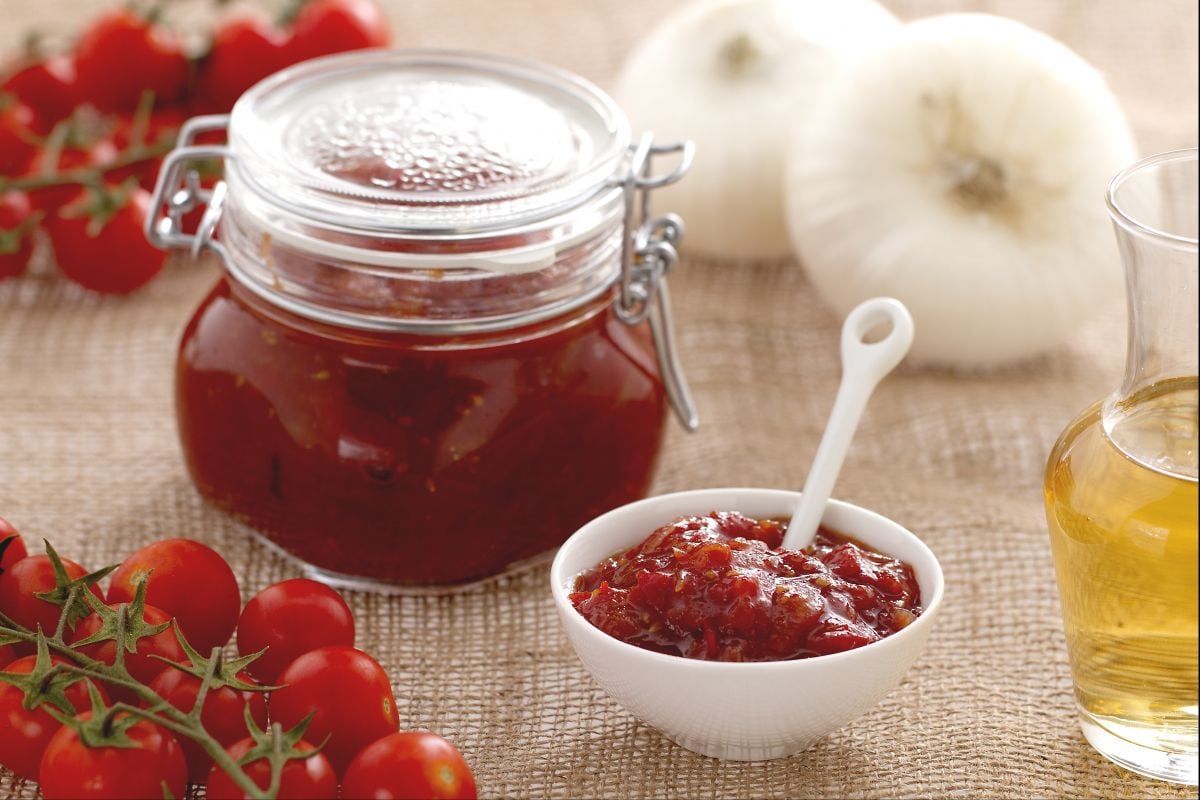Cherry Tomato Chutney

- Gluten Free
- Lactose Free
- Vegetarian
- Vegan
- Energy Kcal 46
- Carbohydrates g 9.8
- of which sugars g 9.7
- Protein g 1.1
- Fats g 0.3
- of which saturated fat g 0.05
- Fiber g 0.9
- Sodium mg 294
- Difficulty: Easy
- Prep time: 15 min
- Cook time: 60 min
- Makes: pieces
- Cost: Low
- Note + the time for sanitizing the jars
PRESENTATION
Chutney di pomodorini is a super tasty twist on the classic Indian chutney that’s been around since the seventeenth century. This version? It swaps the usual mango or tamarind for sweet cherry tomatoes, adding a Mediterranean flair. Really, it’s got this thick, almost jammy texture—kind of like a relish but with a unique flavor profile. You can keep it chunky by leaving in the tomato pulp or strain it for a smooth finish.
The thing is, this condiment shows how a dish can travel across cultures and still feel right at home. What makes this ricetta chutney di pomodorini so appealing? It’s super super versatile. You can pair it beautifully with spicy Indian snacks like samosas or even grilled meats. And the sauce? It complements rice or crusty bread. Chutney di pomodorini fatta in casa is perfect for any palate—keep it mild for a soft tangy kick, or spice it up with chili for a chutney di pomodorini piccante. It’s the balance of sweet and sour that keeps everyone reaching for more.
Plus, making a batch is satisfying. I mean, it’s the kind of thing you can stash in the fridge for a quick flavor boost. For real. Whether you’re adding a homemade salsa di pomodorini to a snack board or looking for a new twist on Indian cuisine, this chutney offers a little taste of both worlds. It really really shows how a simple idea—mixing fruit, sugar, and spices—can turn out bold, colorful, and, honestly, incredibly easy to love. Try it as a side, a topping, or even a dip. Pretty much a fantastic way to enjoy a touch of Indian culinary tradition with a modern twist.
You might also like:
- INGREDIENTS
- Ingredients for 26 oz of chutney
- Cherry tomatoes 7 cups (1 kg)
- Brown sugar ½ cup (100 g)
- Apple cider vinegar ¾ cup (200 ml)
- White onions 1
- Cloves 2
- Fine salt 1 ¾ tsp (10 g)
How to prepare Cherry Tomato Chutney

To prepare the cherry tomato chutney, start by washing and drying the cherry tomatoes well. Then place them on a cutting board and cut them in half 1. Then peel the white onion, cut it in half, and slice it thinly 2. Now take a large pot and add the halved cherry tomatoes and sliced onion 3.

Pour the apple cider vinegar 4 into the mixture you are preparing, also add the brown sugar 5 and salt 6.

Finally, add the cloves 7 and cook everything over low heat for 1 hour from the first boil 8, until you get a thick mixture. The tomatoes should not completely disintegrate. Once cooked, remove the cloves from the mixture 9.

Now take care of sanitizing the jars where you want to store your cherry tomato chutney, following the Ministry of Health guidelines found at the bottom of the recipe. Carefully wash the jars under water and check that there are no cracks or chips on the surface. For jars with airtight seals, also wash the gasket and set aside 10. Line a large pot with a clean cloth and place the jars inside with the opening facing up, wrap other cloths around the jars to prevent them from breaking during cooking, and pour the water into the pot until it is filled 11. Bring to a boil and cook for another 30 minutes. Add the lids ten minutes before draining. Allow cooling, then drain them and let them dry upside down on a kitchen towel 12.

Transfer the still-hot cherry tomato chutney into the jars 13 that you have sanitized, leaving at least 0.4 inches of space from the rim of the jar, close 14, and store in a cool, dry place, first ensuring that the vacuum has been correctly formed 15. If you are using jars with rubber gasket closures, when consuming the cherry tomato chutney, you can test the vacuum by pulling the tab: if pulling it produces a sharp noise, it means that the content has been preserved correctly with a vacuum. On the other hand, if pulling the tab the gasket is "soft," it means the vacuum was not created correctly and it's better not to eat the content. If you are using jars with twist-off lids, close tightly but not too tightly and let them cool. With the heat of the mixture, the vacuum will form, which will allow the product to be preserved for a long time. Once the jars have cooled, check if the vacuum has formed correctly: you can press the center of the lid, and if you do not hear the classic "click-clack," the vacuum has occurred. Once you have verified that the preservation was successful, your cherry tomato chutney is ready to be enjoyed!